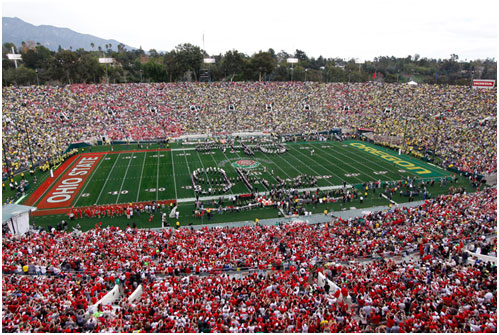The 2010 Rose Bowl: "The Granddaddy of Them All"
In the time-honored New Year’s Day tradition, huge crowds gathered in Pasadena, CA for the 121st Tournament of Roses Parade and the 96th Rose Bowl Game. Ohio State fans were jubilant as their Buckeyes defeat the Oregon Ducks, 26-17.
This year, for the first time, Rose Bowl security measures included the use of our RealityVision® product. While we cannot speak to the operational details, we can say that the product was successfully used in coordinated activities by the U.S. Department of Homeland Security and local California HAZMAT response teams.
As with other high-profile events where RealityVision has been used—the Super Bowl, the Democratic and Republican conventions, the Presidential Inauguration, the Academy Awards and others—several common themes endure:
- The security preparations are an enormous undertaking, extending well beyond protecting the venue on the day of the event. Many federal, state and local employees, as well as private individuals are involved for weeks or months in setting up local or remote operational centers, conducting field investigations and ongoing threat assessments, and coordinating physical logistics. Depending on the event and the location, the security bubble can extend for miles and can include monitoring the skies, nearby waterways and underground access points. Often, the many individuals involved in security for these large events are physically dispersed across the country. For example, some federal agencies have dedicated support teams that travel from event to event as they maintain continuous contact with their home offices.
- As always, there is a premium on coordinating information flows among the many participants. For example, below is a partial view of the FBI-Detroit Police Department joint operations center for the 2006 Super Bowl, where dozens of agencies maintained an active presence in the days leading up to the event. This was the first field trial for our RealityVision software, and you can see me running our console while the integrated display shows live video and GPS positioning being streamed by FBI field agents

The room filled up for each day’s daily briefings as everyone worked to assemble a “common operating picture.” The challenge is in sharing critical information in real-time with widely dispersed personnel, including rapidly-moving field agents, remote experts and decision-makers up the chain of command. It is one thing to receive a verbal description over the radio of a suspicious package or a potential person of interest, but quite another to see continuous live images and to be able to share your own images, securely and in real-time.
- First responders are receptive to new technologies that make their jobs easier. As Law Enforcement Technology Magazine reported:
“The official-in-charge of FBI security at the 2006 Super Bowl considers RealityVision as a force multiplier. ‘The software allowed us to communicate directly with teams and then appropriately respond depending on what we saw.’ Acting as an intelligence gathering tool, the software allows law enforcement to handle issues officers were not previously able to do, he adds. The potential for in-field identification rose by the ability to transmit an image or video of a suspect and then with integrated technologies, such as facial recognition software, analyze the suspect’s picture for identification.”
That’s where Reality Mobile can help. Our RealityVision platform allows critical and time-sensitive information to be collected at unprecedented speed and instantly shared with everyone who needs to see it. Whether users are at a local operations center, at or nearby the event, or monitoring the action from a remote location, everyone is able to access a shared vision of the event. Consider the Rose Bowl as a recent example, as a limited number of field agents seek to guard the 93,000 spectators at the game:

This and other game photos are available on the website of the proud The Ohio State University.
And, in the case of the Rose Bowl, all the hard work paid off, as the day concluded with no major security incidents:
“With help from the Los Angeles County Sheriff’s Department, California Highway Patrol, and the Los Angeles Department of Transportation, the Pasadena police department provided a safe environment for the Rose Parade and Rose Bowl game. Interim Chief Chris Vicino said he is ‘very proud of the way our police department engaged with community members and visitors, providing the right type of security for a ‘family atmosphere’ to be enjoyed by all.’ He went on to say that during the parade the department arrested 41 people. Most of the arrests involved public intoxication, and a ‘handful’ for assault. At the game 13 were arrested – most, again, for public intoxication.” Pasadena Independent , January 6, 2010.
